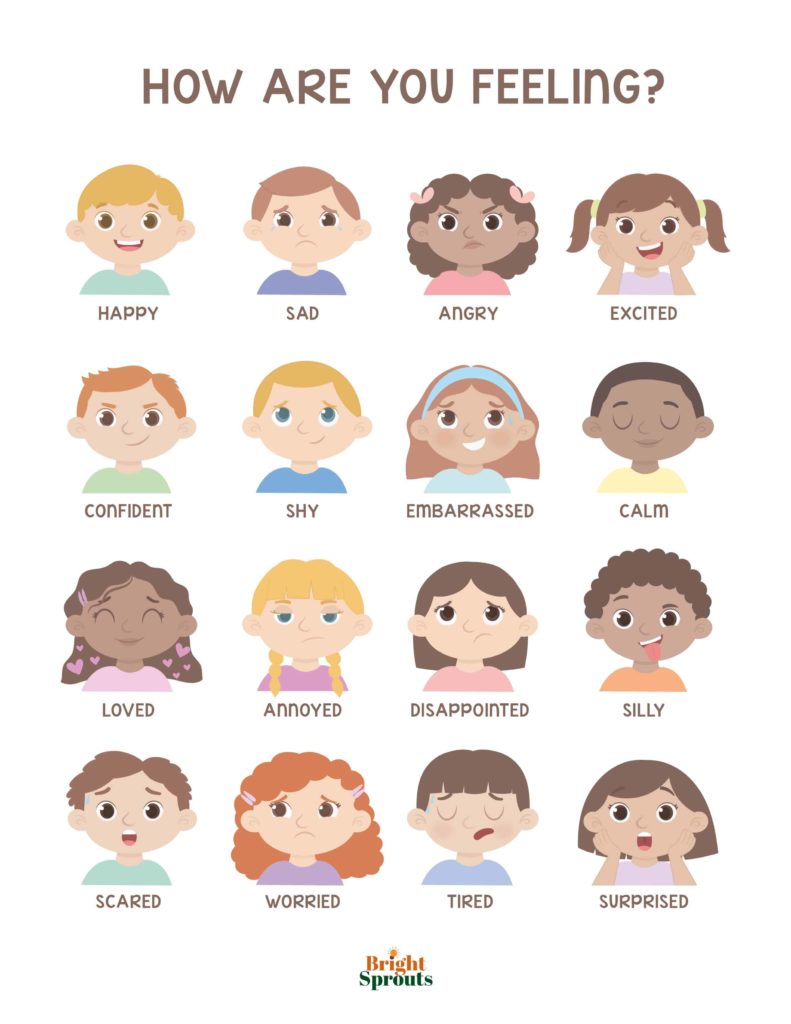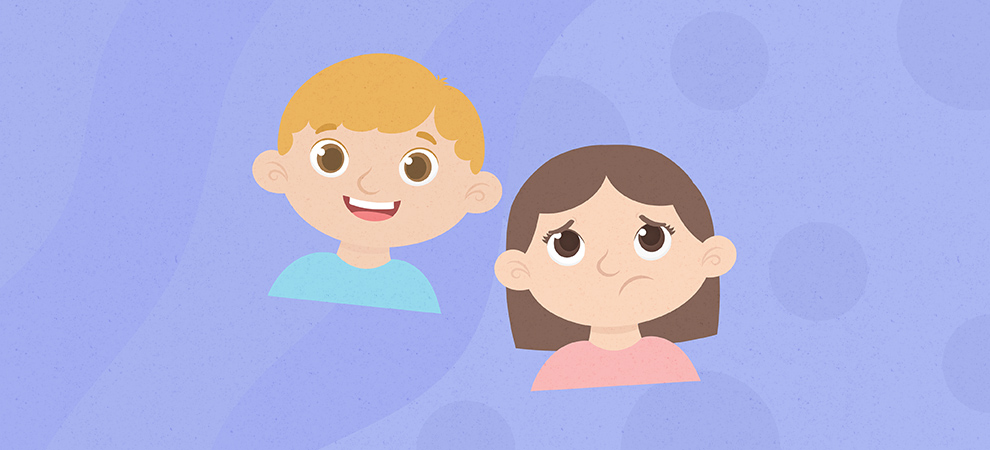Diving into understanding emotions is the most impactful parenting decision you can make. It is a vital first step in teaching empathy and fostering a connection built on trust and respect.
A feelings chart for kids is a positive way to give your child the vocabulary they need to express feelings. Using an emotions chart, children can identify different feelings and process their emotions. This can encourage them to respond rather than react to those feelings.

Let’s Talk Emotions
Emotions are vital in how we see and experience the world around us. Different emotions provide information about people and situations. Emotions prompt us to take action and influence our decisions.
We experience feelings in three ways:
- Subjectively: How we experience the emotion.
- Physiologically: How we react physically to the emotion.
- Expressively: The behavior we use to respond to the emotion.
Emotions motivate our actions and help us make decisions. They help us avoid danger, and allow us to make sense of the world.
Why Identifying Emotions is Important
Being a parent means teaching our children life skills that they will need as adults. When children can use words to identify their feelings, their emotional intelligence develops.
When children can identify their feelings, they can respond to them rather than react to them. Emotions can be tricky for kids to navigate, but they act as a traffic light for self-regulation. Feelings can help children assess situations and make important decisions.
When a child can recognize how they are feeling, it is powerful. It helps the child feel autonomous and in control. It allows them to reframe their thoughts and ask for help if they need it. Recognizing their feelings empowers children. It helps them self-regulate and learn empathy.
Benefits of Good Emotional Health
Regulating emotions is crucial for adult life. Using a feelings chart can help parents and kids with understanding emotions.
Good emotional health means:
- You respond to emotion rather than react.
- You can handle challenges positively.
- You are resilient.
- You have better relationships.
- You will be less anxious.
- You will be in better physical health.
- You are less likely to engage in unhealthy behaviors and habits.
Parents and Social-Emotional Learning
Your children rely on you to learn about their emotions. Talking to your children about their feelings and modeling self-regulation is important.
We all experience big emotions sometimes. Allow your kids to see you struggle with overwhelming feelings. It helps develop a connection based on trust and respect.
When your child has a hard time, it is important to be present in the moment with them. Focus on listening to what they are saying. It is important to respect the individual child and their emotions.
This is especially true in a classroom setting. Teachers deal with individual students and their feelings daily.
Emotional Invalidation
Using an emotions chart is only beneficial when you accept your child’s feelings. If you get angry or dismiss what they are feeling, it defeats the point and can make them frustrated. It also sends the message that what they are feeling is ‘wrong’.
When you invalidate a feeling, your child can feel anxious. It can also damage the trust in your relationship. When children feel judged for their emotions, they can suppress them. This can make them feel lonely and isolated.
Experiencing emotions is healthy. We need to recognize that identifying feelings is a sign of emotional intelligence. It is also critical in your child’s development.
Feelings Chart and Why You Need One
Feelings charts help kids identify what they are feeling. They allow them to communicate those feelings with adults and other kids. Using a chart allows kids to link their feelings to words. This is better than reacting to a physical response those feelings cause.
A feelings chart offers a safe space and a point of connection for parents and children. They help children learn to identify and express their feelings in a calm and positive way. They allow children to focus on what they are feeling and talk about how that emotion feels in their bodies.
Emotions and Behavior
Psychologist Dr. Robert Plutchik developed the wheel of emotions. It described eight primary emotions.

Our feelings affect our behavior. A feelings chart is a vital tool for kids learning to express emotion. For example, if your child is angry or mad, they can express that feeling by hitting, throwing, or kicking. If they are sad, your child might be withdrawn, lethargic, or tearful.
An emotion expressed by your child can also trigger your own feelings and behavior. A feelings chart is not just for kids but can be a valuable tool for parents.
When you struggle to deal with your child’s feelings, why not do a body scan and emotion check? This will help you identify your tension and examine why you are frustrated. Identifying your own feelings first is vital. You can then sit with your child in a calm and positive way as they express their big feelings.
Emotions and Your Body
Emotions can manifest physically. Naming emotions can teach children the language they need to talk about their feelings. This is a healthy option for them physically and mentally.
If you are happy, you smile. If you are angry, your muscles tense up, and your blood pressure increases. If you are scared, your heart rate speeds up, and you can start to sweat. This is a simple example of how feelings can manifest. Everyone reacts to emotion differently making awareness of emotions crucial.
If we haven’t given our kids the words to describe their feelings, they will struggle to talk about them. For example, a child feeling anxious might say they have a sore stomach. That is what anxiety might feel like to them.
Emotions, Empathy, and Connection
Feelings help us connect. For our kids to develop empathy and compassion, they need to relate to what others are feeling.

Here are ways that feelings charts can foster connection and empathy:
- Feelings help kids understand different perspectives.
- Acknowledging their feelings helps them relate to others.
- Accepting their feelings allows kids to be self-motivated and advocate for their needs.
Here are ways that you can help as a parent:
- Listening to your child will make them feel supported and understood.
- You can express empathy while still holding your boundary.
- Communicate through reflective questions that mirror their feelings.
- Model self-control and emotional regulation by identifying your own feelings.
Naming Feelings
Helping your child name their feelings is important. It allows them to communicate through language rather than a behavioral response. When you give an emotion a name, you encourage your child to think about how they are feeling. This helps them use words to understand why they feel that way.
Using a mood chart for kids will help them understand feelings in relation to others. For example, you can use real-life situations to identify emotions. Or you can use a printable feelings chart with images, colors, or facial expressions is also beneficial. Use simple, age-appropriate words that your child can easily understand and relate to.
How and When to Use a Feelings Chart for Kids
A feelings chart is an invaluable resource for families. But, you need to use them in the right way to be effective.
If your child is overwhelmed by emotion, then a chart will not help. Encouraging them to use words when big feelings are buffeting them will worsen the situation.
When your child is calm, you can sit with them and talk about their feelings. Then you can walk them through other emotions related to the main feeling.
How to use a feelings chart effectively:
- Put it in a visible place with easy access.
- Make it a part of your daily rhythm and use it as a point of connection during the day.
- Create a comfortable space around the chart that feels safe for your child.
Let your child create their own chart. They can decide what emotions to include in it, positive and negative.
Empower Your Child with a Feelings Chart
Helping your child identify their emotions is invaluable. It gives them the confidence to understand themselves and their feelings. It will also create a deeper connection in your relationship.
So, equip your child with the tools they need to grow into a compassionate and empathetic person. One who understands that emotions are part of being human. A wonderful part at that.
